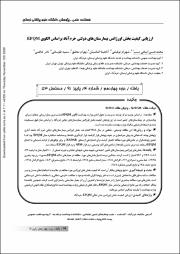| dc.contributor.author | Imani-Nasab, mohammad hasan | en_US |
| dc.contributor.author | Tofighi, shahram | en_US |
| dc.contributor.author | Almasian, anahita | en_US |
| dc.contributor.author | Mohaghegh, bahram | en_US |
| dc.contributor.author | Toosani, somaye | en_US |
| dc.contributor.author | Khalesi, nader | en_US |
| dc.date.accessioned | 1399-08-21T21:41:26Z | fa_IR |
| dc.date.accessioned | 2020-11-11T21:41:26Z | |
| dc.date.available | 1399-08-21T21:41:26Z | fa_IR |
| dc.date.available | 2020-11-11T21:41:26Z | |
| dc.date.issued | 2012-12-01 | en_US |
| dc.date.issued | 1391-09-11 | fa_IR |
| dc.identifier.citation | Imani-Nasab, mohammad hasan, Tofighi, shahram, Almasian, anahita, Mohaghegh, bahram, Toosani, somaye, Khalesi, nader. (2012). Quality assessment of emergency wards in Khorramabad public hospitals based on EFQM model. scientific magazine yafte, 14(4), 17-27. | en_US |
| dc.identifier.issn | 1563-0773 | |
| dc.identifier.uri | http://yafte.lums.ac.ir/article-1-869-en.html | |
| dc.identifier.uri | https://iranjournals.nlai.ir/handle/123456789/483089 | |
| dc.description.abstract | Background: Based on recommendation of management development and organizational change center of the ministry of health. EFQM model is the most appropriate model to deploy in country`s hospitals. In this study we assess quality of emergency wards in khorramabad hospitals based on EFQM model and compare it with results of annual evaluation of the ministry of health.
Materials and Methods: this descriptive, cross-sectional study was carried out in 2009. Emergency wards of khorramabad hospitals were our study population which were selected using census method. Data collection tool was questionnaire of EFQM model which was filled out by researchers in studied wards. RADAR logic used for scoring and EFQM consensus process used for agreement. The data were analyzed through descriptive statistics, SPSS and EFQM softwares.
Results: Scores of studied wards (Social security, Shahid Madani,Shohaday-e Ashayer and Asali hospitals) were 216,108.1,129.9,72.1 respectively. The mean score in EFQM criteria were: leadership 12.3%, policy and strategy 7.1%, staff 11.8%, partnerships and resources 13.8%, processes 20.8%, customers results 8.3%, staff results 12.5% society results 9.5%, key performance results 18.8%.
Conclusion: Findings show that quality of studied wards is less than the model standards and other similar studies considerably. From view point of the researcher the existing gap with external studies is logical and in comparison with internal studies is irrational. The studied wards acquired the most score in process criterion and the least score in policy and strategy criterion. Also ,findings shows a negative relation between results of assessment based on EFQM model and current evaluation system of the ministry of health, so it is suggested that the current system should be revised fundamenally. | en_US |
| dc.format.extent | 402 | |
| dc.format.mimetype | application/pdf | |
| dc.language | English | |
| dc.language.iso | en_US | |
| dc.relation.ispartof | scientific magazine yafte | en_US |
| dc.relation.ispartof | مجله علمی پژوهشی یافته | fa_IR |
| dc.subject | Quality assessment | en_US |
| dc.subject | Emergency wards | en_US |
| dc.subject | EFQM excellence model. | en_US |
| dc.title | Quality assessment of emergency wards in Khorramabad public hospitals based on EFQM model | en_US |
| dc.type | Text | en_US |
| dc.type | Research | en_US |
| dc.citation.volume | 14 | |
| dc.citation.issue | 4 | |
| dc.citation.spage | 17 | |
| dc.citation.epage | 27 | |





